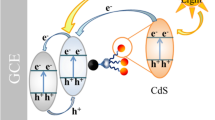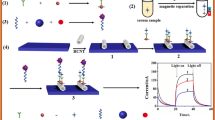Abstract
The proof-of-concept of sensitive electrochemical immunoassay for the quantitative monitoring of human epidermal growth factor receptor 2 (HER2) is reported. The assay is carried out on iron nitrogen-doped carbon (FeNC) nanozyme-modified screen-printed carbon electrode using chronoamperometry. Introduction of target HER2 can induce the sandwiched immunoreaction between anti-HER2 monoclonal antibody-coated microplate and biotinylated anti-HER2 polyclonal antibody. Thereafter, streptavidin-glucose oxidase (GOx) conjugate is bonded to the detection antibody. Upon addition of glucose, 3,3′,5,5′-tetramethylbenzidine (TMB) is oxidized through the produced H2O2 with the assistance of GOx and FeNC nanozyme. The oxidized TMB is determined via chronoamperometry. Experimental results revealed that electrochemical immunosensing system exhibited good amperometric response, and allowed the detection of target HER2 as low as 4.5 pg/mL. High specificity and long-term stability are acquired with FeNC nanozyme-based sensing strategy. Importantly, our system provides a new opportunity for protein diagnostics.
Graphical Abstract






Similar content being viewed by others
Data Availability
Data will be made available on request.
References
Zuo W, He M, Zheng H, Liu Y, Liu X, Jiang Y, Wang Z, Lu R, Shao Z (2021) Serum HER2 levels predict treatment efficacy and prognosis in patients with HER2-positive breast cancer undergoing neoadjuvant treatment. Gland surge 10(4):1300–1314
Mishra S, Kachhawa P, Jain AK, Thakur RR, Chaturvedi N (2022) High sensitivity label-free detection of HER2 using an al–gan/gan high electron mobility transistor-based biosensor. Lab Chip 22:4129–4140
Zeng R, Li Y, Li Y, Wan Q, Huang Z, Qiu Z, Tang D (2022) Smartphone-based photoelectrochemical immunoassay with Co9S8@ZnIn2S4 for point-of-care diagnosis of breast cancer biomarker. Research 2022:9831521. https://doi.org/10.34133/2022/9831521
Marchiò C, Annaratone L, Marques A, Casorzo L, Berrino E, Sapino A (2021) Evolving concepts in HER2 evaluation in breast cancer: heterogeneity, HER2-low carcinomas and beyond. Semin Cancer Biol 72:123–135
Cheng L, Huang Y, Chen Y, Zhang S, Dai H, Lin Y (2023) Chelating and pendant dual-antenna effect modulated ratiometric electrochemiluminescence system for lung cancer marker assay. Sens Actuators B Chem 388:133791
Zhang S, Huang Y, Ren H, Chen Y, Yan S, Dai H, Lv L (2023) Facile and portable multimodal sensing platform driven by photothermal-controlled release system for biomarker detection. Biosens Bioelectron 235:115413
Zeng R, Xu J, Liang T, Li M, Tang D (2023) Photocurrent-polarity-switching photoelectrochemical biosensor for switching spatial distance electroactive tags. ACS Sens 8:317–325
Zeng R, Xu J, Lu L, Lin Q, Huang X, Huang L, Li M, Tang D (2022) Photoelectrochemical bioanalysis of microrna on yolk-in-shell Au@CdS based on the catalytic hairpin assembly-mediated CRISPR-Cas12a system. Chem Commun 58:7562–7565
Zeng R, Wang W, Chen M, Wan Q, Wang C, Knopp D, Tang D (2021) CRISPR-Cas12a-driven MXene-PEDOT:PSS piezoresistive wireless biosensor. Nano Energy 82:105711
Zeng R, Luo Z, Su L, Zhang L, Tang D, Niessner R, Knopp D (2019) Palindromic molecular beacon based Z-scheme BioCl-Au-CdS photoelectrochemical biodetection. Anal Chem 91:2447–2454
Zeng R, Gong H, Li Y, Li Y, Lin W, Tang D, Knopp D (2022) CRISPR-Cas12a-derived photoelectrochemical biosensor for point-of-care diagnosis of nucleic acid. Anal Chem 94:7442–7448
Huang Y, Zhang S, Chen Y, Dai H, Lin Y (2022) Modular and noncontact wireless detection platform for ovarian cancer markers: electrochemiluminescent and photoacoustic dual-signal output based on multiresponse carbon nano-onions. Anal Chem 94(38):13269–13277
Chen Y, Wei J, Zhang S, Dai H, Lv L, Lin Y (2022) Photothermal triggered clinical swab point-of-care testing diagnostics: fluorescence-pressure multi-signal readout detection of cervical cancer biomarker. Chem Eng J 436:135205
Su X, Liu X, **. ACS Nano 17:4077–4088
Lobry M, Loyez M, Debliquy M, Chah K, Goormaghtigh E, Caucheteur C (2023) Electro-plasmonic-assisted biosensing of proteins and cells at the surface of optical fiber. Biosens Bioelectron 220:114867
Zhao Q, Zheng L, Gao Y, Li J, Wei J, Zhang M, Sun J, Ouyang J, Na N (2023) Dual active centers linked by a reversible electron station as a multifunctional nanozyme to induce synergetically enhanced cascade catalysis for tumor-specific therapy. J Am Chem Soc 145:12586–12600
Zhao S, Li H, Liu R, Tao N, Deng L, Xu Q, Hou J, Sheng J, Zheng J, Wang L, Chen W, Guo S, Liu Y-N (2023) Nitrogen-centered lactate oxidase nanozyme for tumor lactate modulation and microenvironment remodeling. J Am Chem Soc 145:10322–10332
Zeng R, Li Y, Hu X, Wang W, Li Y, Gong H, Xu J, Huang L, Lu L, Zhang Y, Tang D, Song J (2023) Atomically site synergistic effects of dual-atom nanozyme enhances peroxidase-like properties. Nano Lett 23:6073–6080
Zeng R, Luo Z, Zhang L, Tang D (2018) Platinum nanozyme-catalyzed gas generation for pressure-based bioassay using polyaniline nanowires-functionalized graphene oxide framework. Anal Chem 90:12299–12306
Yu L, Chang J, Zhuang X, Li H, Hou T, Li F (2022) Two-dimensional cobalt-doped Ti3C2 MXene nanozyme-mediated homogeneous electrochemical strategy for pesticides assay based on in situ generation of electroactive substances. Anal Chem 94:3669–3676
Hu W-C, Pang J, Biswas S, Wang K, Wang C, **a X-H (2021) Ultrasensitive detection of bacteria using a 2D MOF nanozyme-amplified electrochemical detector. Anal Chem 93(24):8544–8552
Wu J, Yang Q, Li Q, Li H, Li F (2021) Two-dimensional MnO2 nanozyme-mediated homogeneous electrochemical detection of organophosphate pesticides without the interference of H2O2 and color. Anal Chem 93:4084–4091
Chen Y, Jiang B, Hao H, Li H, Qiu C, Liang X, Qu Q, Zhang Z, Gao R, Duan D, Ji S, Wang D, Liang M (2023) Atomic-level regulation of cobalt single-atom nanozymes: engineering high-efficiency catalase mimics. Angew Chem Int Ed 62:e202301879
Wang Y, Cho A, Jia G, Cui X, Shin J, Nam I, Noh K-J, Park BJ, Huang R, Han JW (2023) Tuning local coordination environments of manganese single-atom nanozymes with multi-enzyme properties for selective colorimetric biosensing. Angew Chem Int Ed 62:e202300119
Yu D, Zhang H, Liu Z, Liu C, Du X, Ren J, Qu X (2022) Hydrogen-bonded organic framework (HOF)-based single-neural stem cell encapsulation and transplantation to remodel impaired neural networks. Angew Chem Int Ed 61:e202201485
Jiao L, Yan H, Wu Y, Gu W, Zhu C, Du D, Lin Y (2020) When nanozymes meet single-atom catalysis. Angew Chem Int Ed 59:2565–2576
Peng C, Pang R, Li J, Wang E (2023) Current advances on the single-atom nanozyme and its bioapplications. Adv Mater. https://doi.org/10.1002/adma.202211724
Xu B, Wang H, Wang W, Gao L, Li S, Pan X, Wang H, Yang H, Meng X, Wu Q, Zheng L, Chen S, Shi X, Fan K, Yan X, Liu H (2019) A single-atom nanozyme for wound disinfection applications. Angew Chem Int Ed 58:4911–4916
Zeng R, Qiu M, Wan Q, Huang Z, Liu X, Tang D, Knopp D (2022) Smartphone-based electrochemical immunoassay for point-of-care detection of SARS-Cov-2 nucleocapsid protein. Anal Chem 94:15155–15161
Zeng R, Lin L, Gong H, Li Y, Xu J, Huang L, Wang W, Lin S, Tang D, Guo S (2023) Tuning the rate-determining step of uric acid electrooxidation over single-atom-site metal centers for high-performing sensing. Chem Catal 3:100514
Zeng R, Su L, Luo Z, Zhang L, Lu M, Tang D (2018) Ultrasensitive and label-free electrochemical aptasensor of kanamycin coupling with hybridization chain reaction and strand-displacement amplification. Anal Chim Acta 1038:21–28
Lu L, Hu X, Zeng R, Lin Q, Huang X, Li M, Tang D (2022) Dual-mode colorimetric-photothermal sensing platform of acetylcholinesterase activity based on the peroxidase-like activity of Fe–N–C nanozyme. Anal Chim Acta 1229:340383
Sharma S, Zapatero-Rodríguez J, Saxena R, O’Kennedy R, Srivastava S (2018) Ultrasensitive direct impedimetric immunosensor for detection of serum HER2. Biosens Bioelectron 106:78–85
Zeng Q, Liu W, Lin S, Chen Z, Zeng L, Hu F (2022) Aptamer hb5 modified terahertz metasurface biosensor used for specific detection of HER2. Sens Actuators B Chem 355:131337
Loyez M, Lobry M, Hassan EM, DeRosa MC, Caucheteur C, Wattiez R (2021) HER2 breast cancer biomarker detection using a sandwich optical fiber assay. Talanta 221:121452
Wang Z, Chen Q, Zhong Y, Yu X, Wu Y, Fu F (2020) A multicolor immunosensor for sensitive visual detection of breast cancer biomarker based on sensitive nadh-ascorbic-acid-mediated growth of gold nanobipyramids. Anal Chem 92:1534–1540
Ou D, Sun D, Lin X, Liang Z, Zhong Y, Chen Z (2019) A dual-aptamer-based biosensor for specific detection of breast cancer biomarker HER2 via flower-like nanozymes and DNA nanostructures. J Mater Chem B 7:3661–3669
Du C, Jiao J, Zhang H (2023) Biomimetic nanochannels for molybdate transport: application to sensitive electrochemical immunoassay for HER2. Microchim Acta 190(2):53
Wignarajah S, Chianella I, Tothill IE (2023) Development of electrochemical immunosensors for her-1 and her-2 analysis in serum for breast cancer patients. Biosensors 13(3):355
Díaz-Fernández A, Ferapontov A, Vendelbo MH, Ferapontova EE (2023) Electrochemical cellulase-linked elasa for rapid liquid biopsy testing of serum HER-2/neu. ACS Meas Sci Au 3(3):226–235
Funding
Authors acknowledged financial support from the National Natural Science Foundation of China (Grant nos.: 22274022 and 21874022).
Author information
Authors and Affiliations
Contributions
Mingha Qiu: conceptualization, experimentation, writing—original draft, formal analysis, and investigation. Yuqing Ren: experimentation, formal analysis, and investigation. Lumin Huang: experimentation and formal analysis. Xueying Zhu: experimentation and formal analysis. Tikai Liang: experimentation and formal analysis. Mei** Li: material characterization and data analysis. Dian** Tang: conceptualization, supervision, funding acquisition, resource, and writing—review and editing.
Corresponding authors
Ethics declarations
Ethical approval
All experiments were performed in compliance with the relevant laws and Guidelines of Fuzhou University (China), and the experiments have been approved.
Informed consent
Informed consent was obtained from all individual participants included in the study.
Conflict of interest
The authors declare no competing interests.
Additional information
Publisher's Note
Springer Nature remains neutral with regard to jurisdictional claims in published maps and institutional affiliations.
Rights and permissions
Springer Nature or its licensor (e.g. a society or other partner) holds exclusive rights to this article under a publishing agreement with the author(s) or other rightsholder(s); author self-archiving of the accepted manuscript version of this article is solely governed by the terms of such publishing agreement and applicable law.
About this article
Cite this article
Qiu, M., Ren, Y., Huang, L. et al. FeNC nanozyme-based electrochemical immunoassay for sensitive detection of human epidermal growth factor receptor 2. Microchim Acta 190, 378 (2023). https://doi.org/10.1007/s00604-023-05964-z
Received:
Accepted:
Published:
DOI: https://doi.org/10.1007/s00604-023-05964-z




